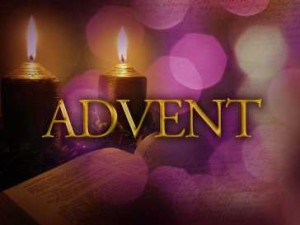 Increasingly Advent (the period of four weeks before Christmas Day) has become associated with the period of time between Thanksgiving and Christmas Eve. This is the time when we ‘shop till we drop’, go to parties, watch Christmas movies, fill our world with Christmas lights and music and wish everyone ‘Happy Holidays’! It seems to equate with the ‘Holiday Season’ and ends on Christmas Day (sometimes with Christmas trees being discarded on the side of the street by the afternoon).
Increasingly Advent (the period of four weeks before Christmas Day) has become associated with the period of time between Thanksgiving and Christmas Eve. This is the time when we ‘shop till we drop’, go to parties, watch Christmas movies, fill our world with Christmas lights and music and wish everyone ‘Happy Holidays’! It seems to equate with the ‘Holiday Season’ and ends on Christmas Day (sometimes with Christmas trees being discarded on the side of the street by the afternoon).
However 50 years ago, Advent was a very different experience (at least according to my family in Europe.) Advent was a time of preparation of soul and body for the joy of the Christmas Season, which in those days meant the twelve days of Christmas ending on January 6th. This day was when the coming of the three Wise Men (or Kings) to bring gifts to the baby Jesus was celebrated. In much of Eastern Europe, this was the day when children received gifts (rather than Christmas morning). In the West, January 6th was celebrated in France as the feast of the three kings with a special cake being baked and in Ireland it was known as ‘Little Christmas’ with various celebrations, including the baking of a ‘three kings cake’ containing three rings to be found with much excitement.
Back in those days, Advent was viewed as a mini-Lent. It was a period of four weeks rather than six, and people fasted, but not as severely as during Lent. A poem called ‘Advent’ by Patrick Kavanagh talks of ‘dry black bread’ and ‘sugarless tea’. This poem clearly illustrates the understanding of people in times past, ‘Through a chink too wide there comes in no wonder’. In order to prepare for something special it was necessary to deal with the jadedness of a world where nothing is special. Through familiarity we get used to our world and take it for granted. So as Patrick Kavanagh says, ‘penance will charm back the luxury of a child’s soul’ in each of us. Then we are ready to enjoy, and appreciate the twelve days of Christmas. People are ready to party, to celebrate and enjoy each other. By their experience of Advent they have learnt again that it is important to savor the good things of life and take nothing for granted. Their hearts are filled with gratitude and they are open to the presence of God in all things, ‘and Christ comes with a January flower’.
Some of this past understanding of Advent can still be found today. You will notice that purple is worn by the priest during both Advent and Lent; the difference is in the shade of purple! Purple can symbolize pain, suffering, and therefore mourning and penitence. It is the liturgical color of Lent. It is also the color of royalty and traditionally has also been used for Advent. It is still used in Catholic churches but blue is replacing purple for Advent in many Protestant churches. The difference in ‘purple’ between Lent and Advent is that, in Lent, a deeper darker shade is used since Lent is the time we ask God to prepare us for Our Lord’s death (before ‘all things being made new’ Easter morning). Advent purple is a lighter shade with a hint of pink. After all, the third Sunday of Advent is ‘Joyful’ Sunday and is represented by a pink candle (rather than purple) in the advent wreath. We would do well to remember that we are awaiting a baby’s birth and it would be heartbreaking not to notice ‘God’s breathe in common statement’!

